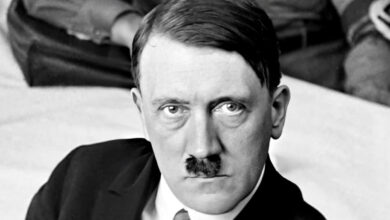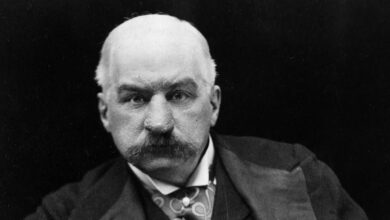Podcast: Play in new window | Download
Subscribe: Spotify | Amazon Music | Youtube Music | RSS
Katharine Houghton Hepburn was born on 12 May 1907 in Hartford, Connecticut, USA. Her father, Thomas was a urologist at Hartford hospital and helped to establish the New England Social Hygiene Association, whereas her mother, who was also called Katharine was a campaigner for the feminist cause, being actively involved in the suffrage movement. She also campaigned for birth control.
Katharine was the second eldest of six children and as a child, she was somewhat of a tomboy who kept her hair short and called herself Jimmy. She not only learned to swim, run, and dive, she also played tennis and golf, and even wrestled.
Katherine had an older brother called Tom but in 1921 when she was 13 and her brother was 15, tragedy struck the family when, during a visit to a friend of their mother’s in New York, Katharine found the body of her brother, who had apparently taken his own life. This had a profound effect on Katharine, who adored Tom, and her behaviour became erratic, and she eventually dropped out of school.
However, after lots of encouragement, and to a certain extent, insistence, from her parents, Katharine enrolled at Bryn Mawr College in 1924, and even though she struggled, mainly due to the fact that she wasn’t interested in academic studies, she managed to graduate with a degree in history and philosophy in 1928. It is at Bryn Mawr College that she first got a taste for acting.
After graduation Katharine moved to Baltimore with the intention of becoming an actress and was cast in a small role in a stage production called The Czarina. The play’s producer, Edwin H. Knopf enjoyed her performance and so gave her a chance as the leading lady in his production of The Big Pond, but on the opening night she made a mess of her lines and was fired. For the next six months, she was only able to get understudy parts.
Also in 1928, Katharine Hepburn married a businessman called Ludlow Ogden Smith, but it never really worked out and the couple was divorced in 1934 although the pair remained friends until his death in 1979. She never married again and never had any children.
For the next few years, she only managed to get small parts until she landed the lead role in a Greek fable called The Warrior’s Husband. The play ran for three months from March 1932, and it got her noticed.
In the same year, she was offered a part in a movie called A Bill of Divorcement in which she starred opposite John Barrymore. The movie was a hit and so Katherine Hepburn’s profile jumped another notch leading to an immediate return to the big screen in Christopher Strong the following year.
1933 turned out to be a great year for her as she also appeared in Morning Glory as Eva Lovelace, for which she received an Academy Award for Best Actress and as Jo in Little Women, both of which were also hits. Unfortunately, though, her career didn’t continue its upward trajectory as the next few films and plays she starred in were flops and her reputation was negatively impacted.
Soon after her move to California in 1932, Katharine Hepburn began a relationship with Leland Hayward who was her agent. They were both married at the time, but when he proposed marriage after they were both divorced, she declined, declaring that she liked the idea of being her own single self.
1936 saw Hepburn nominated as Best Actress at the 8th Academy Awards for her work on Alice Adams. In the same year, whilst touring with Jane Eyre she began an affair with Howard Hughes after having been introduced to him by Cary Grant the year before. He also wanted to marry her, but she ended the relationship in 1938 after moving away from Hollywood, with the intent of continuing the resurrection of her career.
Eventually, she managed to a land a stage role as Tracy Lord in The Philadelphia Story, which turned out to be a huge hit and ran for 417 performances. She reprised the role in the movie version of the play in 1940 and this was also a huge hit and led to her third Academy Award nomination. It also led to her signing a contract with MGM where she met and fell in love with Spencer Tracy. Her on screen relationship with him spanned 26 years and 9 movies but her off screen relationship was never officially acknowledged as Tracy, although estranged from his wife, was married.
Hepburn continued to have a mixed career through the 1940s with several of her movie projects not proving popular at the box office although she did receive a fourth Academy Award nomination for Woman of the Year in 1943. Things began to look up when she sought out tougher roles in the likes of The African Queen in 1951, for which she received her fifth Academy Award nomination and Pat and Mike in 1952.
Four more Academy Award nominations followed for Summertime in 1956, The Rainmaker in 1957, Suddenly, Last Summer in 1960 and Long Day’s Journey Into Night in 1963.
After completing work on Eugene O’Neill’s Long Day’s Journey Into Night, Katharine Hepburn took a break from her career to devote time to caring for an ailing Spencer Tracy who died on 10 June 1967.
After Tracy’s death, Hepburn returned to acting and received an Academy Award for her appearance in Guess Who’s Coming to Dinner in 1967 and again in 1968 for The Lion in Winter, which she shared with Barbra Streisand for Funny Girl.
As the 1960s came to an end, Hepburn turned her attention to television and this is where she did most of her work through the 1970s and 1980s, although she was awarded a fourth Academy Award for her appearance in On Golden Pond in 1981.
Her last appearance in a movie was in a made for television role in 1994’s One Christmas and her health soon began to deteriorate afterwards.
She had been hospitalised in 1993 for exhaustion and was hospitalised again in 1996 with pneumonia, but in May of 2003 a tumour was found in her neck. The decision was taken not to operate and following a heart attack on 29 June the same year, Katharine Hepburn died at the age of 96. Although we have described Katharine Hepburn’s career as mixed, according to IMDB, she left behind a legacy of 53 acting credits that resulted in 37 nominations for various awards, 28 of which she won. These include 4 Academy Awards, an Emmy Award, 2 BAFTAs, 2 People’s Choice Awards and a Lifetime Achievement Award from the Screen Actor’s Guild. She also has a star on the Hollywood Walk of Fame.
Podcast: Play in new window | Download
Subscribe: Spotify | Amazon Music | Youtube Music | RSS




